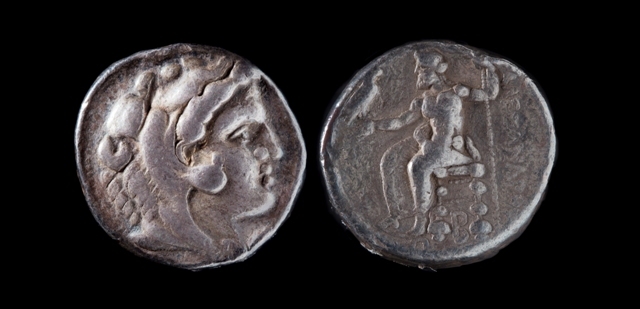Macedonian, Silver Tetradrachm
Dublin Core
Title
Macedonian, Silver Tetradrachm
Subject
Macedonian Kingdom, Alexander III (the Great) (336-323 BCE), Tarsus (Cilicia) mint, Silver Tetradrachm, 333-327 BCE.
OBVERSE: Young head of Herakles, wearing Nemean lion's skin. In profile, facing right.
REVERSE: Zeus seated on throne with knobbed legs, facing left, feet on footstool. He holds an eagle in his outstretched right hand and a scepter in his left. Inscription ALEXANDROU (= "of Alexander") in right field. Mint mark "B" below throne.
OBVERSE: Young head of Herakles, wearing Nemean lion's skin. In profile, facing right.
REVERSE: Zeus seated on throne with knobbed legs, facing left, feet on footstool. He holds an eagle in his outstretched right hand and a scepter in his left. Inscription ALEXANDROU (= "of Alexander") in right field. Mint mark "B" below throne.
Description
The coinage of Alexander the Great has been found all over the ancient world. It is believed to be one of the most widely circulated coinage in all of antiquity. This obverse portrait is one of the most famous images associated with Alexander.
On the obverse, we see a young, beardless Herakles. This image was common among Macedonian kings since Herakles was said to be their ancestor.
Alexander conquered the city of Tarsus in 333 BCE. Zeus, featured on the reverse of the coin, is a fitting symbol of this new kingship. Interestingly, however, he seems to be sitting on a Persian style throne. Some scholars have suggested this unusual iconography is because the former Persian satrap of area, Mazaios, had minted very similar coins featuring Baal of Tarsus holding an eagle. Whether because the artists only knew how to draw one sort of throne, or by Alexander’s own design, the result of this similarity was beneficial to the new king. The Greek military could interpret the coins as Zeus, a symbol of their power and domination of the area, and the locals could interpret it as their own deity, Baal. The coincidence helped Alexander both secure the loyalty of his troops and convince the locals of his respect for their culture.
On the obverse, we see a young, beardless Herakles. This image was common among Macedonian kings since Herakles was said to be their ancestor.
Alexander conquered the city of Tarsus in 333 BCE. Zeus, featured on the reverse of the coin, is a fitting symbol of this new kingship. Interestingly, however, he seems to be sitting on a Persian style throne. Some scholars have suggested this unusual iconography is because the former Persian satrap of area, Mazaios, had minted very similar coins featuring Baal of Tarsus holding an eagle. Whether because the artists only knew how to draw one sort of throne, or by Alexander’s own design, the result of this similarity was beneficial to the new king. The Greek military could interpret the coins as Zeus, a symbol of their power and domination of the area, and the locals could interpret it as their own deity, Baal. The coincidence helped Alexander both secure the loyalty of his troops and convince the locals of his respect for their culture.
Source
Gift of James and Aneta McIntyre, Hallie Ford Museum of Art, Salem, OR. 2006.010.013
Rights
Hallie Ford Museum of Art
Format
2.380 cm
16.800 gr
16.800 gr
Language
Greek
Type
Coin
Identifier
Alexander the Great, Herakles
Coverage
This item can be viewed on the Hallie Ford Museum of Art's website.
Citation
“Macedonian, Silver Tetradrachm,” Hallie Ford Museum of Art Exhibits, accessed January 2, 2026, https://library.willamette.edu/hfma/omeka/items/show/65.
